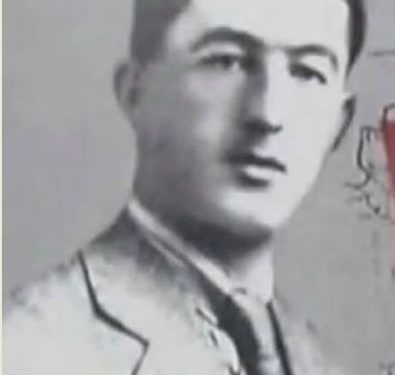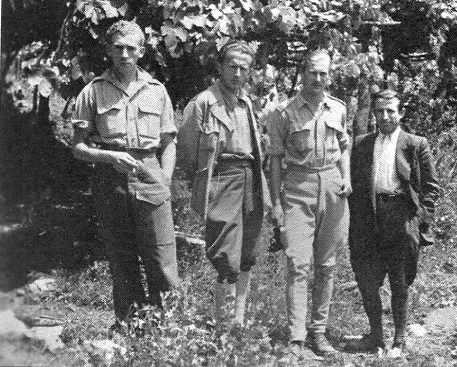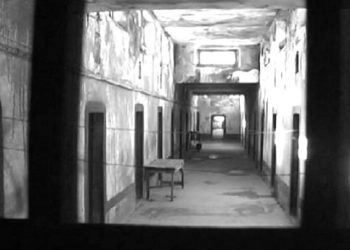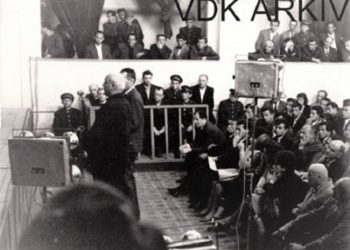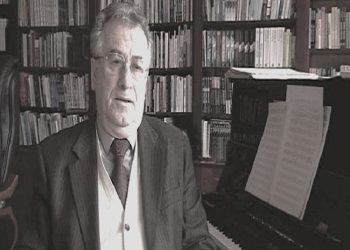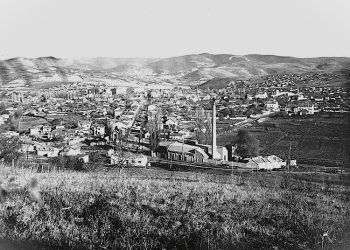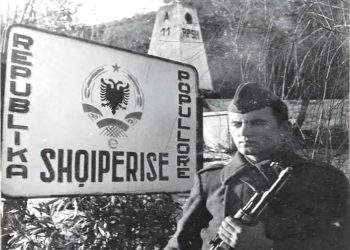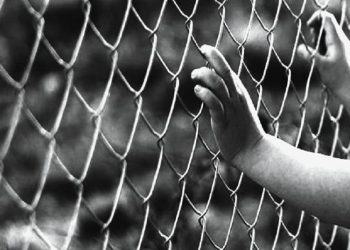By Petrit A. Velaj
Part Two
Memorie.al / During the years of World War II, the waves of the Anti-Fascist War swept us away without us realizing it. We were schoolmates, like city boys, me, Bajram Tushi, Hajredin Bylyshi, Hiqmet Buzi, Mumin Selami (Kallarat). Amidst dreams and desires and the romance of literature. With these friends of mine, I have many memories. Our parents, our mothers, honest and generous people. A patriotic mother, mother Tina of Tol Arap, the well-known patriot, gathered us around her like a nest of birds. She was the mother of my childhood friend, whom we called: “the flower of Vlora’s youth”, Vllas Arap. I think Mumin Kallarati gave this epithet to Vllas. I associated with every friend and comrade who was honest and sincere.This united us in our society with our peers: Hazis Sharra, Qemal Xhyheri, Xhemil Beqo, etc. Although our opinions were different, we went together to picnics, play games and go to the cinema. A meeting at Lef Sallata’s house. Suddenly, politicized thoughts erupted in our society. The debate flared up with the young revolutionary, Kastriot Muço. He was an honest man. After four or five days, Kastriot said to me: “Petrit, when are you going to hold the youth meeting in the Çerekçie neighborhood? In the city’s activity, you were elected responsible for the neighborhood’s youth group”. After a few days, we organized the youth meeting in the “Çerekçie” neighborhood.
Continued from the previous issue
As soon as he found out that one of the main points of its program was Kosovo and Chameria, he raised his eyebrows and frowned. That’s why the Albanian communists frowned too. This made Mustafa Gjinishi pay with his head and Ymer Dishnica paid with the ordeal of his life. After a while, the youth liaison, Mr. Bego Gjonzeneli, called me, who told me to go to Vlora. They ordered me to take all the propaganda tools, the equipment and go to Tragjas, also with Hodo Meto, Adem Hodo, Fatosh Kokoshi and Xhelil Ymer. We stayed in Mehmet Alemi’s house. There, in a basement, we worked for some time. But since someone reported us, we took the materials and went to Ravenna…! September 1943 came. Even today, when I write these memories, I believe that future historians will know how to judge even better on the facts and documents to extract the truth.
I say this because whenever I remember the Battle of Drashovica, for 50 years it was not mentioned that the nationalist forces also fought there. In the Battle of Drashovica, September 1943, both the partisan forces and the fighters of the “National Front” participated. I remember that in foreign communiqués at the time, it was said: “In the War of Drashovica, both the ‘reds’ and the ‘whites’ fought.” The partisans were represented by Hysni Kapo. Their fighting location was on the hills beyond the Shushica River, at the foot of the village of Kropisht. The forces of the “National Front” were on the Vodicë Passes, Mazhar, Lapardha. They were commanded by Tasim Murati, Feim Çelua, Hasan Hyso, Neki Selami, etc. The first signal was given by the young Hekuran Xhindi, together with two others, who cut the barbed wire surrounding the barracks and ammunition depots. Their tracks were detected by the Nazis and thus the first batteries were fired upon, which spread throughout the Shushica river valley. From the first hours of the fighting, news broke that Hysni Kapoja had been wounded in the leg, and they pulled him on a mule, taking him to the foot of the mountains in the village of Lapardha, as I heard, to the house of Like Kalemi.
In this battle, as brothers, partisans and ballistas fought against the Nazi beast. I remember a folk song that was created and sung since those years: “Ballistas with partisans/ they started a war with the Germans/ Drashovica and the bridge held/ what did you do, my friend, in trouble/ the first batare broke/ those Asllans remained/ together they took the istikam/ and together they gave their blood”! This was the song of the famous Mato Hasani, who my father told me had also composed the song of the Vlora War in 1920, the one entitled “Nuk e tëmë kabull na”, and sang it in the “Flag Square”, when the war ended. The Battle of Drashovica, for twenty nights and days, marked vivid scenes of a fierce war. While standing in positions or during the fighting on the banks of Shushica, we were reminded of the wars of our fathers, also on these hills and banks against another enemy, Italian imperialism. This gave us both strength and heart to fight even more courageously against the Germans. The battle was bloody.
The Germans, with abundant weapons and ammunition, resisted a lot, but the masters of the homeland, stubbornly in the trenches, stood firm and did not retreat. Except, when other forces came to the Nazis for help from Gjirokastra, then our forces retreated to the mountains. The Germans were armed to the teeth. They had put all of Europe under their nails. So our wars could only be partial and striking. After the war of Drashovica, not a few days passed and in the village of Amonica, a meeting was held between Hysni Kapo and some leaders of the “Ball Kombëtar”. Among them was the prominent nationalist elder, Sulo Shehu from the village of Sevaster. For us, the young fighters, he was a famous fighter of the 1920s, the son of Captain Sali Shehu. At that meeting, after listening to Hysni Kapo, he said to him: “I don’t understand who is good for Mukja? For me, Mukja is an Albanian covenant”. Hysni Kapua jumps and replies: “We will no longer adhere to Mukja”.
Immediately the conversation became heated. In the conversation, old Sulo blurted out: “I tell you: kill yourselves, sons, because our hearts do not tell us to deal with traitors, as long as we have the enemy in our hearts.” Speaking about the character of this old man, I am reminded of the Dushkarak meeting of May 1943. That meeting was attended by: from the “Balli Kombëtar”: Hysni Lepenica, Isuf Luzi, Tahir Hoxha, Skënder Muço, from the communists: Enver Hoxha, Mehmet Sheu, Liri Gega, Hysni Kapo. The meeting took place at the house of Temo Shehu, who was also Mehmet Sheu’s first cousin. When I once asked uncle Sulo about this meeting, he told me: “Listen, son, when the masters want to put a pickaxe in the house, the village sits and makes a fuss.” He was talking about the pickaxe that Enver Hoxha was putting to nationalism and patriotism with the communists. During that time, I worked in Ravenna, in those beautiful mountains and plateaus with lime trees and pastures, where I constantly met the generous people of this village. From there, since they dictated to us, we went to Dukat. To the house of Maliq Koshena.
The place where we were staying was called Filipat. I was with Gani Hamiti, Tahir Hoxha, Bego Gjonzenali, Yzeir Ismaili. Not even 2-3 days had passed when the English major called me, accompanied by a lieutenant and a sergeant, for a meeting at the Tragjas mosque. We young people from all the provinces went there. For several days, the English major trained us in the use of weapons, time bombs, which exploded at a certain moment. I saw that the commander of the guerrilla unit against Italian spies, Mr. Hazis Sako Hazizaj, from Vezhdanishti, was also participating; Behxhet Shahini, Enver Shaska, Hekuran Shaska, Deli Brati, Thanas Aliu, Beqir Jazua, Duro Sheme, Xhevit Havari, Hamdi Gjoni, Isuf Shehu, etc. As an inspector for military tactics, there was Officer Isuf Shehu from Dukat, who also knew English well. He was a wise and decisive man. He taught us how to use Allied weapons. Isufi, with great patience, tried to practice us at the mosque from behind, from the side of the stream, shooting at concrete objects on the ground.
I was instructed in the two-barrel mortar, as well as the use of British bombs, which were like melons and shattered the world. Meanwhile, Mit’hat Frasheri and Hasan Dosti, accompanied by Skënder Muço, came from Tirana for an organization of the “Ballit Kombëtar”, a meeting was organized at Rrepet e Dukati, near the school. Mehmet Alemi welcomed us here. He spoke about the path of the “Ballit Kombëtar” in Vlora, about the war against the Italian occupier and the combat organization. After him, the commander of the Dukati platoon, Maliq Koshena, took the floor. When he spoke, he held in his hand an automatic rifle, captured by the fascist militia, and he swore an oath with it in front of the people of the Duchy. Placing his palm on the butt of the automatic rifle, he said: “I will not let go of this weapon until the enemies of the homeland are exterminated.” A powerful cry erupted and two drops of tears rolled down the cheeks of old Frashërlli…” He stood up and did not let the matter drop.
Among other things, he said: “I ask you to reconcile even the bloods with each other”. All the people answered: “So is it”! Mit’hati did this because in Dukat, at that time, there was also a feud between the Koshen tribe and Mustafa Myslyut. Both tribes were strong, honest and with patriotic traditions. After the meeting, in June 1943, they went to Gani Hamiti’s house, where they discussed the problems of the war and the province. Gani had large rooms. The elections of the Regional Committee of the “National Front” were also held there. Mr. Skënder Muço was elected representative of the “National Front” in the Central Committee. Professor Hysni Alimerko was elected Secretary of the Regional Committee of the “National Front” who alone, broke away from his communist tribe. In this meeting, participated: Kudret Kokoshi, Zako Mezini, Bego Gjonzeneli, Mulla Azem Shehu, Sulo Shehu, Isuf Luzi, Hysen Çobo, Galip Haxhiu, Yzeir Ismaili, Sadik Shaska, Hasan Hyso, Hamdi Çeperrati, Shahin Nuredini, Rrapo Metua, Xhemil Meço, Temo Shehu, Tasin Jonuzi, Selahedin Peshkëpia, Mihal Peço, Kujtim Beqiri, Abdyl Sharra, Hazis Sharra etc.
With the capitulation of fascist Italy and the arrival of the Nazi Germans, Commander Hysni Lepenica, instructed by the Central Committee of the “Ballit Kombëtar”, went to Grehot, where the Italian Division “Ferrara” was located, to receive the weapons. The Italians had agreed that the next day, at around 11 o’clock, the surrender of weapons and ammunition would take place. But before the appointed time, secretly and incognito, Bedri Spahiu and Shemsi Totozani, as well as Beso Gega, had gone there. They treacherously agreed with the Italians to eliminate the military leader of the “Ballit Kombëtar”, Mr. Hysni Lepenica, who was at the gate of the Division. After the scream that was heard in the direction of the Italian guards, the order was given to shoot and thus the Grehoti war began. The murder of Hysni Lepenica was a national mourning for all the nationalists of the provinces. In the struggle with the Italian soldiers, who had entered the trenches, the entire Hysni Lepenica platoon was killed. One was taken prisoner. Only three remain alive. Today, Sadik Sinani lives in Lepenica, as a living witness to the treacherous war of Grehoti.
He told me that more than 150 Italians were killed in that battle. Of the fighters of Hysni Lepenica platoon, which consisted of the leaders of many platoons of the “Ball Kombëtar”, and had the name “Shqiponja”, about 36 people were killed. The battle took place in the dark, as it was afternoon. The Grehoti massacre is shrouded in mystery and has become a legend. Within a short time, the reorganisation of the fighting forces of the “Ball Kombëtar” took place. Kadri Cakrani was appointed commander. The Grehoti tragedy caused the relations between the “National Front” and the Communist Party to become extremely tense. It went so far that, in addition to the assassinations carried out by the partisans against the partisan forces, ambushes were also set up and fire was exchanged. On October 16, 1943, when I myself was in Hazis Çami’s battalion, in the camp in Tragjas, we went from house to house to wash and change, as well as to celebrate the day of Eid. We were hit by surprise. The hits came on the afternoon of October 16, from the Tragjas fortress and the Çiraku Gorge, from the direction of the village of Radhima.
The partisans attacked us, shooting us mercilessly with two mortars, two heavy machine guns placed in the Tragjas fortress, manned by Italian officers. They did not leave us alone until dark. We were scattered. Some to the vineyards of Yzeir Muço, others to the water line of Izvor, some to the houses of Mehmet Alemi and Tahir Hoxha, in the Tragjas field. Amid the flames and the crackling of machine guns, we heard women screaming. A student at the ‘Normale’ of Elbasan, Lufter Hoxha, son of the honorable Tahir Hoxha, with a pine tree in his hand took the women out of the house, setting fire to his own house. While his father, Tahir Hoxha, with his younger brother Bardhon, fourteen years old, was in the ranks of the “Ball Kombëtar”, Lufter with the other brothers, in the partisan ranks. According to the order, we of the “Ball Kombëtar”, went to Dukat where we held a meeting at the house of Maliq Koshena. The word spread that, how could an Albanian, especially the son of Tahir Hoxha, burn his own house?!
In the middle of the conversation, the English major, who was based in the village of Mazhar in Lapardha, also arrived. As if in a low voice, he tells us that what happened in Tragjas was a disagreement, a misunderstanding…! At this meeting, the reorganization of the forces of the “Ballit Kombëtar” for the Vlora region was carried out. From here, delegates of the “Ballit Kombëtar” were charged with the reorganization in other villages and regions. I, with a letter from the “Ballit Kombëtar” Region, was sent news to return to Vlora. There we would reorganize the youth of the “Ballit Kombëtar”. A meeting was held at the house of Hazis Sharra. It was October 1943. The tasks were also divided for each. In those days, suddenly, the flower of the nationalist youth of Vlora, Hazis Sharra, was struck. He was hit by the bullets of six assassins, on the “Muradies” street, from Abdyl Kuçi’s house, to the “Korça” hotel. The assassins, who entered the house, also received the return of Haziz’s bullets, and fled in the darkness.
He was the liaison of the Mediterranean Headquarters with the forces of the Albanian “Ball Kombëtar”. He had organized the rapid landing of the Allied troops in the Dukat and the Coast. Apparently, as Mit’hat Frashëri also told me, the Germans, through their agents, found out about the work done by Skënder Muço. We were at Rrushit Rroi’s house in Shkodër, when we learned that in early November 1944, all the leaders of the “Ball Kombëtar”, led by Mit’hat Frashëri, came to this city. More than three hundred young people gathered. After a few days, Sulejman Meçua returned from the Mediterranean Headquarters and told us: “Militarily, for now, the National Liberation Army has it. This won’t last long. To protect our people, we must leave Albania…”! These words were passed from mouth to mouth among nationalists throughout the city. Memorie.al
To be continued in the next issue







